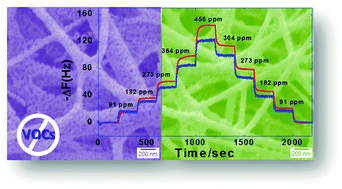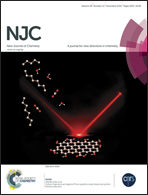VOC sensors based on a metal oxide nanofibrous membrane/QCM system prepared by electrospinning†
Abstract
We report a simple synthetic route to fabricate crystalline ZnO and CeO2/ZnO nanofibrous mats and their sensing characteristics against volatile organic compounds (VOCs) such as benzene, propanol, ethanol, and dichloromethane. Precursor fibers were fabricated by electrospinning of poly(vinyl alcohol) and metal salt(s) at 2.5 kV cm−1 in aqueous solution. The fibers were directly deposited on the crystal surface of a quartz crystal microbalance (QCM). The crystal, which was coated by nanostructured PVA/metal precursor(s) fibers, was subjected to calcination in air at 500 °C for 5 h. The formation of an oxide based nanofiber mat was revealed by scanning electron microscopy and X-ray diffraction. Upon exposure of the nanofiber mats to the VOCs, the compounds adsorbed onto the surface of oxidic fibers. The physisorption of the compounds was confirmed by FTIR and QCM. Both systems showed sensitivity to the VOCs and they hold a broad promise particularly for sensing applications of volatile alcoholic compounds. The introduction of CeO2 into the ZnO structure reduced the sensitivity of ZnO most probably due to the decrement of oxygen vacancies.



 Please wait while we load your content...
Please wait while we load your content...